Safety Around Train Tracks

When a driver’s vehicle became disabled on some train tracks in Ocala, the driver and a passenger did the smart thing: they exited the car. Moments later the oncoming cargo train crashed into the vehicle, smashing it to smithereens. Luckily, smart thinking by the individuals in the vehicle meant there were no injuries.
Railroad Crossing Safety
We’ve all crossed train tracks at some time in our lives—and generally we do it with little concern. But the truth is, according to the National Highway Traffic Safety Administration, we should give such locations special attention every single time we come upon them:
- Remember the old adage: stop, look, and listen. Don’t rely on external warnings alone to guide your progress across tracks.
- Understand that many trains—particularly freight trains,–do not travel at regular schedules—so expect a train at any time.
- Never stop on tracks! If you don’t have room to get across due to traffic, then pause before getting to the tracks.
- If there are red flashing lights, the lates have been lowered, there is a stop sign, or there is a flagman signaling an oncoming train, stop 15 feet ahead of the tracks.
- If the gates have been down for what seems an unreasonably long time with no sign of a train, don’t drive around the gates.
- After a train has passed, wait for the flashing lights to go off and the gates to rise fully before proceeding through.
- If you find yourself in the same situation as the Oscala driver—stalled out on the tracks—get everyone out of the vehicle immediately and call 911.
Train Facts Worth Knowing
In case you think you might fare well in an encounter with a train, consider these facts:
- On average, a locomotive weighs in at about 400,000 pounds—and some weigh as much as 6,000 tons. That makes the ratio of train to car similar to that of car to soda can. Picture the impact of a car on a can, and then think twice about any confrontations with a train.
- Trains are quieter today than ever before. They can be closer than you think, and moving faster than you’d imagine.
- Trains are able to move either direction any time. You may be expecting forward movement when the reverse occurs.
- Trains often extend as much as three feet beyond the rail—making the safety zone well beyond that distance.
Signal Failures
Sometimes warning systems fail: it’s just a fact. Collisions in that case could be difficult to prevent if motorists are unaware of an oncoming train. If you or a loved one is involved in an auto/train collision, the experienced Kissimmee personal injury attorneys at Salazar & Kelly Law Group are here to help. Schedule a confidential consultation in our Kissimmee office today.
